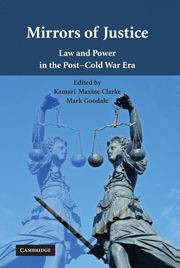Book contents
- Frontmatter
- Contents
- Editor Biographies
- Contributors
- Acknowledgments
- Introduction: Understanding the Multiplicity of Justice
- 1 Beyond Compliance: Toward an Anthropological Understanding of International Justice
- PART I JUSTICE AND THE GEOGRAPHIES OF INTERNATIONAL LAW
- PART II JUSTICE, POWER, AND NARRATIVES OF EVERYDAY LIFE
- PART III JUSTICE, MEMORY, AND THE POLITICS OF HISTORY
- Epilogue: The Words We Use: Justice, Human Rights, and the Sense of Injustice
- Index
- References
Introduction: Understanding the Multiplicity of Justice
Published online by Cambridge University Press: 25 January 2010
- Frontmatter
- Contents
- Editor Biographies
- Contributors
- Acknowledgments
- Introduction: Understanding the Multiplicity of Justice
- 1 Beyond Compliance: Toward an Anthropological Understanding of International Justice
- PART I JUSTICE AND THE GEOGRAPHIES OF INTERNATIONAL LAW
- PART II JUSTICE, POWER, AND NARRATIVES OF EVERYDAY LIFE
- PART III JUSTICE, MEMORY, AND THE POLITICS OF HISTORY
- Epilogue: The Words We Use: Justice, Human Rights, and the Sense of Injustice
- Index
- References
Summary
Since the end of the Cold War twenty years ago, there has been a dramatic increase in the number of international and transnational institutions for which “justice” has become a central ideological ordering principle, an implicit goal, or, in the case of the International Criminal Court (ICC), a formal basis for institutional action. At the same time, there has been a corresponding rise in the prevalence and cross-cultural resonance of justice as a framing discourse, a transnational normativity that gives shape to, but is not coextensive with, the modalities of international law, human rights, and preexisting cultural and moral imperatives. The problem, we might say, of justice is of course an old one indeed: Its complexities have formed the staple of debates within political philosophy for centuries if not millennia; within both theology and international law the centrality of justice has made it an iconic, if shifting, symbol that has at times come to represent the particular system itself. Justice has served as the illusive endpoint of any number of political and social teleologies, the utopian goal toward which movements of ideas and people have been hurled with sometimes tragic, sometimes heroic, consequences.
More recently, however, the withering away of the logics of the bipolar postwar system provided an opening for the actual building and implementation of both international and transnational systems that had existed as either idea or unrealized possibility, including the international human rights system, the interrelated system of international criminal law, and the more diffuse networks of transnational actors that came to constitute what Eleanor Roosevelt, the chair of the commission that produced the 1948 Universal Declaration of Human Rights, called the “curious grapevine.
- Type
- Chapter
- Information
- Mirrors of JusticeLaw and Power in the Post-Cold War Era, pp. 1 - 27Publisher: Cambridge University PressPrint publication year: 2009
References
- 3
- Cited by



